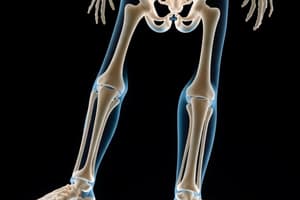Podcast
Questions and Answers
When should pGALS be performed according to the text?
When should pGALS be performed according to the text?
- When a child presents with unexplained pyrexia (correct)
- When a child is diagnosed with Juvenile Idiopathic Arthritis (JIA)
- When a child has inflammatory arthritis
- When a child has known association with musculoskeletal presentations
What are the potentially life-threatening conditions that can present with musculoskeletal symptoms in children?
What are the potentially life-threatening conditions that can present with musculoskeletal symptoms in children?
- Migraines and stomach aches
- Excessive tiredness and lack of appetite
- Allergic reactions and skin infections
- Malignancy, infection, vasculitis, and non-accidental injury (correct)
In what scenario does the lack of reported pain not exclude arthritis?
In what scenario does the lack of reported pain not exclude arthritis?
- When a child experiences gelling and altered function (correct)
- When a child has swelling on the joints
- When a child has difficulty walking
- When a child has a fever and is unwell
What are the presenting features of Juvenile Idiopathic Arthritis (JIA) mentioned in the text?
What are the presenting features of Juvenile Idiopathic Arthritis (JIA) mentioned in the text?
Which of the following pediatric conditions is associated with inflammatory joint disease according to the text?
Which of the following pediatric conditions is associated with inflammatory joint disease according to the text?
Which condition is characterized by a child walking with patella facing forward and toes pointing inwards?
Which condition is characterized by a child walking with patella facing forward and toes pointing inwards?
At what age is metatarsus adductus most likely to resolve in children?
At what age is metatarsus adductus most likely to resolve in children?
Which condition is common between the ages of 3–8 years and is characterized by the child walking with patellae and feet pointing inwards?
Which condition is common between the ages of 3–8 years and is characterized by the child walking with patellae and feet pointing inwards?
What is another term for bow legs in children?
What is another term for bow legs in children?
At what age are knock knees (genu valgus) most commonly maximal in children?
At what age are knock knees (genu valgus) most commonly maximal in children?
What are some red flags that may raise concern about infection, malignancy, or non-accidental injury in a child?
What are some red flags that may raise concern about infection, malignancy, or non-accidental injury in a child?
Why is it important to use a 'copy me' approach when performing pGALS on a child?
Why is it important to use a 'copy me' approach when performing pGALS on a child?
Which of the following would NOT be considered a practical tip in performing pGALS on a child?
Which of the following would NOT be considered a practical tip in performing pGALS on a child?
In what age group is habitual toe walking commonly observed according to the text?
In what age group is habitual toe walking commonly observed according to the text?
What should be considered when interpreting the findings from a pGALS assessment in a child?
What should be considered when interpreting the findings from a pGALS assessment in a child?




